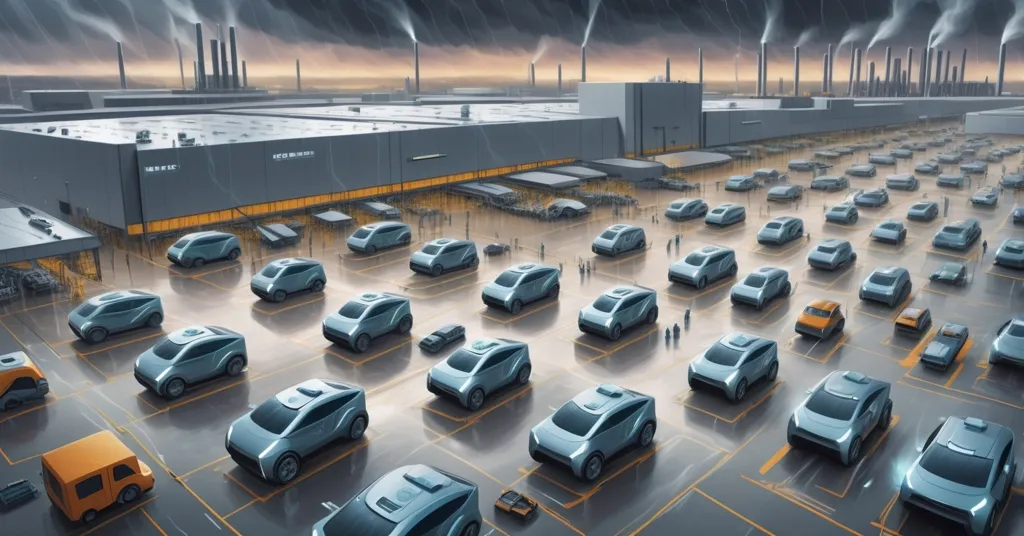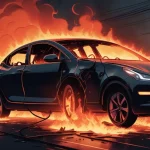Tesla Halts Cybertruck and Model Y Production Again—Robotaxi Gamble Amid Chaos?

Tesla Shuts Down Cybertruck and Model Y Production in Austin—Third Time’s the Charm?
Tesla has announced yet another production halt at its Austin Gigafactory, pausing output of the Cybertruck and Model Y starting June 30. This marks the third shutdown in less than a year, stirring questions about operational stability as the company simultaneously preps for a high-profile robotaxi launch.
- Recurring Disruption: Third production pause at Austin Gigafactory since last December, citing “maintenance” for June 30.
- Delivery Slump: Q1 deliveries down 13%, with under 50,000 Cybertrucks delivered by March 20.
- Robotaxi Rollout: Model Y-based autonomous service targets June 22 launch in Austin, despite looming factory closure.
Production Halts: A Stuttering Engine at Austin
Let’s not mince words: Tesla’s Austin Gigafactory, the powerhouse behind the Cybertruck and the globally dominant Model Y, is hitting the brakes again. Starting June 30, production of both vehicles will cease for what the company vaguely labels as “maintenance.” This isn’t a one-off glitch—it’s the third shutdown in under a year at this Texas hub. Back in December, battery shortages forced a pause; late May saw another halt, partly for voluntary training sessions; and now this. Even April brought a slowdown, with Cybertruck lines scaled back and staff shuffled around. For a company that built its reputation on Elon Musk’s near-fanatical drive for output—think sleeping on factory floors to meet quotas—this string of interruptions feels like a slap in the face to that legacy. Is Tesla just recalibrating, or are we witnessing the cracks in an overstretched empire as it battles declining sales, jittery investors, and ambitious tech gambles?
The numbers don’t lie, and they’re not pretty. First-quarter deliveries tanked by 13% compared to last year, a brutal indicator of either waning consumer interest or persistent supply chain snags—likely both. By March 20, fewer than 50,000 Cybertrucks had rolled out, per a recall filing, despite the electric pickup being hyped as a game-changer. Let’s be real: years of delays and prices that ballooned beyond initial promises have soured the buzz for many, as seen in ongoing Cybertruck production delay discussions. The Model Y, Tesla’s bread-and-butter SUV and the world’s top-selling EV, isn’t dodging the bullet either, even with a refreshed “Juniper” version launched in January. With Q2 delivery figures looming in July, this shutdown could be a gut punch, already reflected in a 2% stock drop following the news. Investors are sweating, and they’ve got reason to. Tesla isn’t operating in a bubble—Chinese giant BYD is carving up the affordable EV market, while industry-wide woes like chip shortages and battery constraints keep the pressure on. Sure, Ford paused its F-150 Lightning for seven weeks last fall, and GM shuttered plants during the 2021 chip crisis, but Tesla’s repeated stumbles at a linchpin facility like Austin? That’s starting to smell like a problem unique to their garage.
So, what’s behind this maddening cycle of stops? Tesla’s “maintenance” excuse for June 30 feels like a cop-out with zero details on what’s being fixed or when production will restart, though some insights into Tesla pausing Cybertruck and Model Y output have surfaced. Compare that to December’s clear battery shortage issue or May’s partial focus on training, and the opacity here is deafening. Are supply chain gaps—say, for next-gen battery tech—still biting them in the rear? Is demand for Cybertruck and Model Y softer than Musk’s team admits, prompting disguised strategic pauses? Or does this tie to a quieter pivot, like abandoning one-piece gigacasting—a fancy manufacturing trick to cast huge car frames in a single mold for efficiency—in favor of a simpler three-piece underbody design, as recent reports on Tesla’s manufacturing shifts suggest? Industry folks like Terry Woychowski from Caresoft Global have called out the questionable economics of gigacasting, while MIT’s James Womack notes such innovations don’t thrill buyers and often drain cash upfront. Tesla’s history of overhyping production wizardry (Cybertruck delays, anyone?) suggests these halts might be the messy reality of scaling back to save a buck. Whatever the truth, the lack of transparency leaves us—and the market—grasping at straws.
Robotaxi Gamble: Future Forward or Reckless Distraction?
Here’s where Tesla’s story gets a wild twist. While production lines prepare to go dark, the company is full-throttle on a robotaxi service slated to launch in Austin on June 22. The plan involves 10 to 20 Model Y vehicles kitted with upgraded Full Self-Driving (FSD) software—a system aiming for complete autonomy, where cars navigate sans human input—to autonomously shuttle from the factory to customers’ homes by June 28, just two days before the shutdown. Musk hyped this on social media, though he tossed in a rare dose of caution about timing, as noted in updates on Tesla’s robotaxi launch.
“We are being super paranoid about safety, so the date could shift.” – Elon Musk
That caution isn’t baseless. FSD is under the microscope from the National Highway Traffic Safety Administration after crashes in low-visibility scenarios, including a fatal pedestrian incident. Musk’s bold claim that all new Teslas can handle unsupervised driving also clashes with reports that millions of older models need hardware upgrades—some of which might not even be doable. This robotaxi rollout, limited and geofenced much like Waymo’s cautious city-bound model, is a far cry from Musk’s 2019 pipe dream of a million driverless cars by 2020, with significant challenges still ahead for robotaxi deployment. Yet it’s still a ballsy bet on autonomous tech over pumping out more EVs, especially with Model Y production grinding to a halt mere days after the first autonomous deliveries. Talk about cutting it close—are they biting off more than they can chew?
Let’s play devil’s advocate for a hot second. What if FSD flops under real-world pressure or regulatory heat? Could this shiny distraction pull focus from fixing core production woes, much like the 2017 ICO craze sucked energy from blockchain’s fundamentals? Tesla’s leadership thrives on big swings, but with delivery numbers in the gutter and Wall Street watching, prioritizing a futuristic gamble over operational grit feels like selling flying cars from a busted factory. On the flip side, if they pull this off, it could redefine Tesla as a tech titan beyond mere carmaking, aligning with the disruptive ethos we admire. Still, the tight timeline and FSD’s rocky track record make this a high-stakes roll of the dice.
Disruption’s Messy Mirror: Tesla and Crypto’s Parallel Struggles
For those of us in the Bitcoin and blockchain trenches, Tesla’s saga strikes a familiar chord, even if it’s not directly tied to crypto wallets. Musk’s short-lived experiment with accepting Bitcoin payments in 2021—before ditching it over environmental concerns—still looms large as a nod to decentralized finance in the mainstream. His influence in our space, from Dogecoin shenanigans to SpaceX’s Bitcoin holdings, keeps him a figure of fascination, with some commentary on Musk’s statements about Tesla demand circulating widely. But the deeper connection lies in the grind of disruption itself. Tesla’s chaotic tango between factory shutdowns and robotaxi moonshots mirrors the crypto world’s own scaling battles—think Bitcoin’s block size wars or Ethereum’s bumpy proof-of-stake transition. Innovation isn’t a straight shot; it’s a slog through failures, pivots, and sheer stubbornness.
As advocates of decentralization, privacy, and effective accelerationism, we see Tesla’s mess as a reflection of our own fight to shatter the status quo. Their focus on autonomous tech over raw EV output echoes how altcoins carve out niches beside Bitcoin’s dominance—each experiments with what the future could be, even if the present is a dumpster fire. Just as Bitcoin challenges centralized banking despite volatility and regulatory pushback, Tesla’s pursuit of a driverless world—production halts be damned—shows a refusal to settle for small steps. It’s ugly, it’s risky, and it might not pan out, but it’s the kind of audacity we can’t help but respect.
Zooming out, there’s a Bitcoin maximalist parallel worth chewing on. Tesla’s core products like the Model Y are their bedrock, much like Bitcoin is the unchallenged king of crypto. Yet their speculative ventures—robotaxis, futuristic manufacturing—akin to altcoin experiments, test uncharted waters. Some will flop, others might redefine the game, but both Tesla and our space thrive on pushing limits while wrestling with the growing pains of mass adoption. It’s not just about cars or coins; it’s about rewriting the rules, flaws and all, even as common issues with Model Y production persist.
Crossroads Ahead: Can Tesla Keep the Wheels Turning?
Tesla finds itself at a pivotal junction, balancing cost-cutting tactics, factory bottlenecks, and a sci-fi gamble on self-driving tech. The Austin Gigafactory’s repeated shutdowns aren’t just hiccups—they’re a crucible testing whether Tesla can match its disruptive vision with the nuts-and-bolts reality of mass production. With Q2 delivery data dropping soon, the pressure is on. Will these pauses be a blip in Tesla’s unstoppable ascent, or do they hint at systemic flaws? Musk and crew feed on chaos, but even chaos has a breaking point when competitors are gaining ground and investors are itching to jump ship, especially considering the impact of the Austin shutdown on the broader EV market.
Much like our own ecosystem, where Bitcoin maximalists and altcoin pioneers debate the path to global impact, Tesla’s journey underscores that real revolution is a brutal, messy affair. Yet, amid the uncertainty, there’s a spark of optimism. If Tesla can weather this storm—streamlining operations while chasing autonomous dreams—they could emerge as a blueprint for how disruptive tech, be it EVs or blockchain, conquers the world. For now, we’re watching a high-wire act, and the next few months will tell if they stick the landing or crash spectacularly.
Key Questions and Takeaways
- What’s fueling Tesla’s repeated production halts at the Austin Gigafactory?
While the June 30 shutdown is pinned on “maintenance,” past pauses linked to battery shortages and training suggest supply chain gaps or sagging demand. Tesla’s silence on details leaves room for speculation about deeper operational struggles. - How could this shutdown hit Tesla’s delivery numbers and investor faith?
Q1 deliveries already fell 13%, and a 2% stock dip post-news signals unease. With Q2 figures due in July, more delays could worsen the slump, further rattling investors in a competitive EV landscape. - Can Tesla juggle the robotaxi launch with factory closures?
Launching on June 22 with autonomous deliveries by June 28—just before the halt—looks logistically dicey. With Model Y production affected and FSD software facing regulatory scrutiny, resources may be stretched thin. - Are Tesla’s woes unique, or tied to wider EV industry trends?
Supply chain issues plague the sector, as seen with Ford and GM shutdowns, but Tesla’s frequent stops at a key hub like Austin point to company-specific challenges beyond typical market turbulence. - How does Tesla’s disruptive push echo blockchain and crypto values?
Tesla’s bet on robotaxis over raw EV production mirrors crypto’s drive for radical innovation—Bitcoin disrupting finance, altcoins testing new frontiers—prioritizing transformative vision over short-term wins, despite the rough road.



